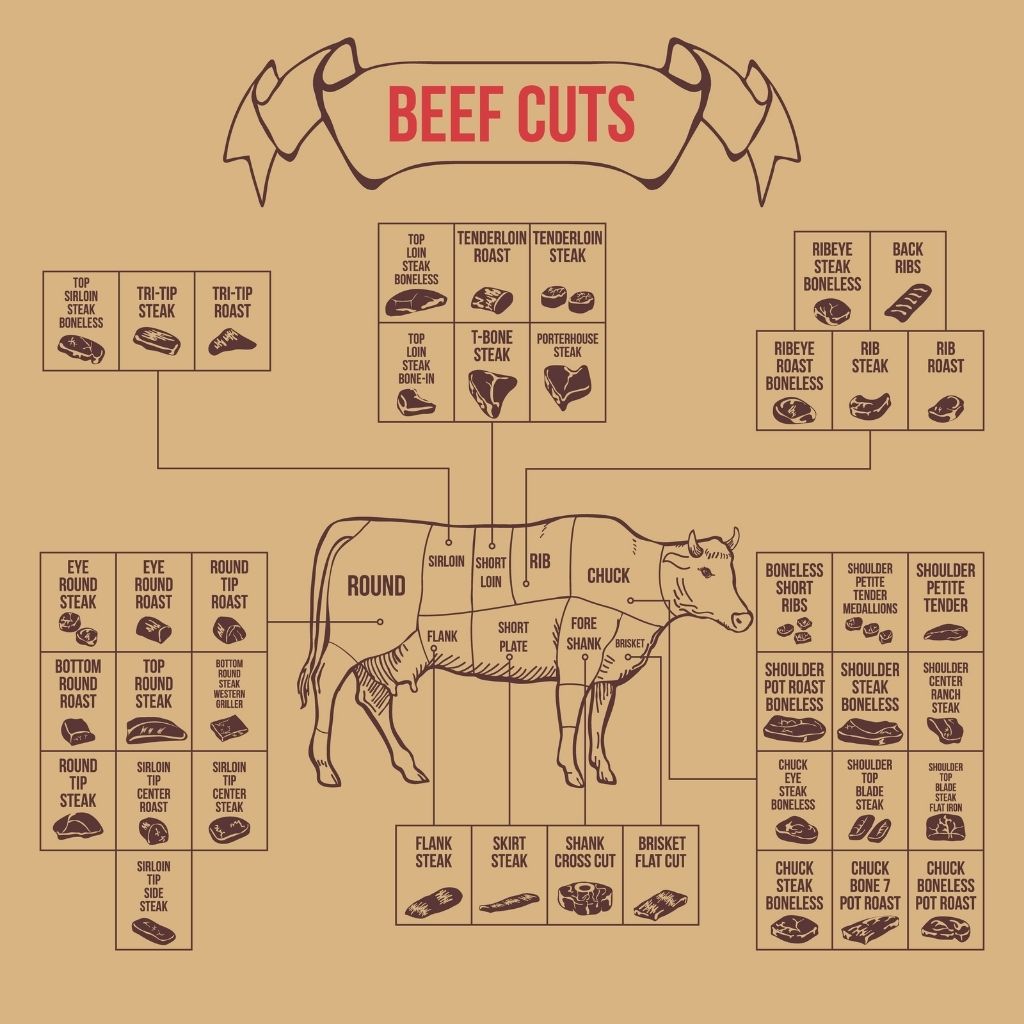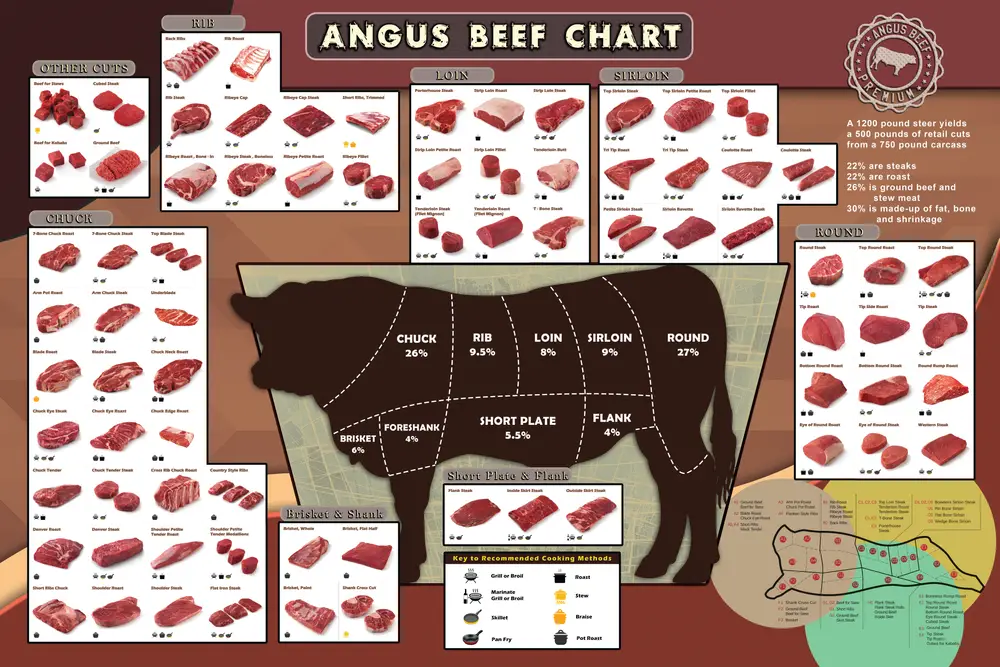There are many beef cuts on a cow that can be confusing for a beginner. It's best to start with having a trusted butcher prepare the first one or two animals you slaughter before you take over. Sit in on the preparation and butchering of these animals to understand the process.
If possible, take plenty of notes and a video of how the butcher works through the carcass.
Table of Contents
Before You Start
The most important things to remember you butcher a beef carcass are always to cut across the grain whenever feasible, use the sharpest knives and saws, and maintain a clutter-free and well-ordered cutting table. Cleanliness, hygiene, and a germ-free environment are paramount in meat preparation, and you should prepare the forequarters and hindquarters accordingly, depending on their use, consumer wishes, and carcass quality.
The butcher will probably have already disposed of the offal destined (or not) for human consumption, such as the head and hooves. You will need to point out in advance if you want to keep items like the liver, kidneys, heart, tongue, cheeks, and oxtail. You may also want to keep the fat and make tallow for baking or frying.
Request that the butcher grinds the fat before giving it to you. This process will make rendering it much more manageable. Even if your butcher charges you extra to do this, it’s definitely worth it.
Know Your Different Cuts

The first step in butchering the cow is to cut the carcass in half along the backbone using a hoist and a gambrel. Lay the half carcass (known as the side of beef) flat on your worktable, with the head to the right.
You are now ready for quartering. The four parts or ‘primals’ are the round, the loin, the rib, and the chuck. The cuts you obtain from the primals are known as the sub-primal cuts.
The Round
Start with the rear leg portion of the steer, known as the round. This section will provide you with roasts and many other cuts. The round has seven cuts: top round, femur bone, shank, bottom round, eye round, oyster steak, and knuckle.
Sitting on top of the aitch bone is the oyster steak. This small steak is very tender, juicy, and tasty, and known as a butcher’s cut, so you’ll rarely see it for sale in a store. Removing the aitch bone to get to the shank requires work as it has some strong tendons holding the femur. The remains of the aitch bone make good stock.
The Shank
Cut away the shank. The shank contains a tough knot of muscles and is suitable for braising. We can now start unbundling the four muscles that make up the round: the top round, the knuckle, the eye round, and the bottom round. The round, sirloin, and chuck tend to produce most ground beef. Top round roast is cut from the interior of the hind legs and is most commonly used as roast beef or pastrami in “deli” sandwiches.
Use of Beef from The Round
Round steaks are versatile: bottom round cuts make the traditional roasts you might have on a Sunday, although they will also go into ground beef or deli meat. Eye of round is tougher than top and bottom round cuts and is often found sliced thin in sandwiches.
Top round, also called top rump, is suitable for rump roast. Cross-cut shanks contain rich meat and shank bone in one package – they are great for making soup, stew, or even beef ossobuco!
The round tip roast (or sirloin tip roast) is from the part of the round next to the sirloin. Center-cut steaks are from between the top and bottom round.
Sirloin Tip Steaks
Remove the cap or the muscle on the top round. You can then start to pull the top round away and reveal the eye round. We’re left with the femur bone, the longest marrow bone in the steer. Separate the knuckle, which contains the sirloin tip steaks. The knuckle itself sits next to the bottom round and is also suitable for making stock.
Only the gooseneck remains now. The gooseneck comprises three muscles: the eye round, the bottom round, and the heel (the tough muscle behind the knee). Remove the eye round, used for roasts, while the heel is good for braising. The bottom round is very tender and is excellent for making roast beef. Ensure you trim all the fat, fascia (or muscle covering), connective tissue, and blood.
The top round provides London broil steaks and is suitable for steak tartare.
The Loin
The loin has two main parts: the drop and the short loin. It will provide you with six cuts: Flank, sirloin flap, top sirloin, tenderloin, tri-tip, and strip loin.
Cut off the flank steak (or skirt steak) and then a part of the drop to reveal the sirloin flap or “bavette.” Pull the suet out of the short loin. Suet is fat that coats and protects the internal organs, such as the kidney. You can render the suet to make tallow, skincare products, and candles. It’s also great for frying. Skirt steak or flank steak often provides the meat you find in fajitas.
The short loin subprimal will provide you with the famous T-bone and Porterhouse steaks. Because it is from the rear end of the short loin, a Porterhouse contains more tenderloin steak. The short loin is known for producing steaks with the most marbling.
Tenderloin steak is also the best for stir-fry.
T-Bone and Porterhouse
Porterhouse and T-bone steaks share the same characteristics in that they feature a roughly T-shaped bone with meat on either side. A T-bone has a strip steak on the longer side and smaller beef tenderloin on the shorter side. A Porterhouse has the same combination but is larger than a T-bone and, as mentioned, features a greater quantity of tenderloin meat.
The favored cooking method for T-bones and Porterhouses is grilling, not frying.
Now you can cut away the tenderloin. Remove the psoas minor by peeling it off laterally. You can obtain the famous filet mignon, regarded as the tenderest cut of all, from the end of the tenderloin.
Next is the strip loin. Remove the loin section, which will provide the New York strip (or Kansas City strip). Dislocate the loin from the sirloin; debone the sirloin, remove the ball tip, and tri-tip or Newport steak. You will end up with the top sirloin steak.
The top sirloin is tenderer but smaller than the bottom sirloin.
The Rib
The rib or primal rib section will provide you with five cuts: the rib itself, the short rib plate (or just ‘short plate’), the outside skirt, the inside skirt, and the navel. There are seven ribs in the primal rib section, one of which is the prime rib.
Remove the navel and the membranes from the inside and outside skirts. The navel is a rough cut and best used for beef bacon or braising. Cut through the cartilage on the rib bones and then saw the rib in half by cutting across the bones.
Cutting the rib in half will give you a flatter short rib plate and the more curved rib. After removing the feather bones, the chine or backbone, and the thick layer of fat, you can now cut ribeye steaks off the rib. One prime rib produces seven rib eye steaks! A tomahawk steak (or cowboy steak) is a large, bone-in ribeye steak from between the 6th and 12th rib.
The plate provides you with the prized “butcher’s steak,” also known as a hanging tenderloin or “hanger steak.“
The rib and loin supply the most expensive cuts. These cuts include the bone-in ribeye, Porterhouse, T-bone, filet mignon, and the Kansas City strip steak.
The Chuck
The most extensive section of the quartered carcass is the chuck. The chuck will give you nine cuts: the chuck and neck, mock tender, flat iron, shoulder clod, underblade, teres major, chuck rib plate, brisket, and foreshank.
Start by removing the sweetbreads. Use a saw and a knife to remove the upper shoulder and neck from the chuck. Remove the chuck rib plate. This rib plate contains the first five ribs. After deboning, the chuck will also provide chuck ribeyes, chuck eyes, chuck roasts, and Denver steaks. Chuck beef is also suitable for soups or neck and pot roast.
Remove the breastbone from the chuck rib plate with a saw. The breastbone is suitable for stock. Cut the brisket away from what’s left of the chuck. Dislocate the shoulder blade, keeping the triceps intact. Now you can remove the foreshank, otherwise known as the arm.
Teres Major
We’re left with the triceps muscle (or ‘clod’) and the scapula. Remove the tender teres major steak and the underblade, suitable for chicken-fried steak. We can now see the shoulder clod, also called the clod heart. This piece is ideal for ranch steaks. Finally, remove the flat iron steak, the second tenderest muscle in the steer, and the mock tender from the scapula.
Chuck steak is well known for becoming more tender the longer you cook it, so it is ideal for slow cooking. It is also great to marinate, as are round and flank steaks. Don’t forget, the tenderer the beef, the shorter the marinade.
The blade steak is a steak cut from muscle in the chuck and is sometimes known as the top blade.
Some Basic Physiology
The carcass of an animal bred for eating comprises bones, fat, muscles, connective tissues, and membranes. Muscle and lean meat are the tastiest and most nutritious cuts of beef, but it is rare to eat this muscle without consuming at least some connective tissue and attached fat.

The ‘lean’ portions of every animal carcass comprise around 300 separate muscles. Only around 25 of these muscles are individual strands or a workable combination. These individual muscles are vastly different from one another.
There is a significant variation in what is known as palatability. Palatability encompasses tenderness, juiciness, and flavor. It depends on how mature or old an animal is and the area of the cut.
The hoof and leg muscles that control locomotion produce more flavorsome but not-so-tender cuts than ones from solely weight-bearing muscles, like the ones along the back. These support muscles are usually tenderer and less tasty.
High-Stress Levels
Animals that have suffered high-stress levels before slaughter or have had some sickness can produce fat that is pinkish or has a reddish hue. The muscle-tissue color of top-quality beef cattle should be a vivid candy-apple red.
Tissue from animals past their prime is almost always duller. You can often find dark yellow fat on some calf carcasses, occurring when the calf has consumed a high amount of green forage and is of a breed unable to transform yellow carotene into the colorless vitamin A. It is also common for older ruminant carcasses to contain yellow fat.
